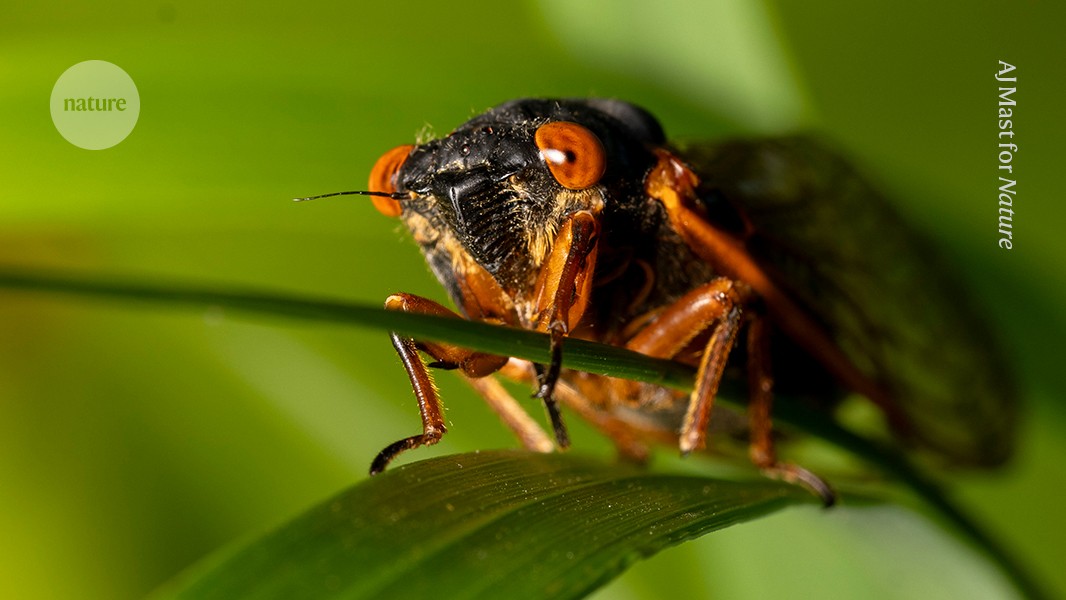Why cicadas shriek so loudly and more: your questions answered

Billions of the insects are making an epic emergence in the eastern United States

A periodic cicada in Illinois, where two broods are emerging this month at once.Credit: AJ Mast for Nature
As spring turns to summer in the United States, warming conditions have started to summon enormous numbers of red-eyed periodical cicadas out of their holes in the soil across the east of the country. This year sees an exceptionally rare joint emergence of two cicada broods: one that surfaces every 13 years and another with a 17-year cycle. They last emerged together in 1803, when Thomas Jefferson was US president. This year, billions or even trillions of cicadas from these two broods — each including multiple species of the genus Magicicada — are expected to swarm forests, fields and urban neighbourhoods.
To answer readers’ cicada questions, Nature sought help from three researchers. Katie Dana is an entomologist affiliated with the Illinois Natural History Survey at the University of Illinois at Urbana-Champaign. John Lill is an insect ecologist at George Washington University in Washington DC. Fatima Husain is a cognitive neuroscientist at the University of Illinois at Urbana-Champaign. Their answers have been edited for length and clarity.
Why do periodical cicadas have red eyes?
JL: We’re not really sure. We do know that cicadas’ eyes turn red in the winter before [the insects] come out. The whole coloration pattern in periodical cicadas is very bright: red eyes, black and orange wings. They’re quite different from the annual cicadas, which are green and black, and more camouflaged. It’s a bit of an enigma why the periodical ones are so brightly coloured, given that it just makes them more obvious to predators. There are no associated defences with being brightly coloured — it kind of flies in the face of what we know about bright coloration in a lot of other animals, where usually it’s some kind of signal for toxicity. There also exist mutants with brown, orange, golden or even blue eyes. People hunt for blue-eyed ones; it’s like trying to find a four-leaf clover.

Entomologist Katie Dana collects cicadas in Monticello, Illinois.Credit: AJ Mast for Nature
Can periodical cicadas see in colour?
JL: They do see colour. But their eyes are basically non-functional when they’re underground. They’re not investing a lot of energy in making the sort of proteins associated with vision when they’re not needed. And so there’s some dramatic, abrupt developmental switch that happens, that probably coincides with the eye colour changing to red. They now need to be able to use their eyes in a new habitat, which is above ground.
Can the two cicada broods interbreed?
KD: We know that they can interbreed when introduced to each other in the lab, but it remains to be seen if it actually happens in a wild setting.
Do cicadas compete to be heard?
JL: Cicadas get together in all-male groups called choruses, and usually in a given tree. Cicadas of a particular species congregate together, put on a big show, and the females are hanging out around the periphery, judging the quality of potential mates. So that’s the reason it’s so loud, but I don’t know the degree to which they’re competing to be heard. They’re obviously trying to distinguish themselves among an already loud group, for the females. And the females are judging something about the quality of the call. But I think the loudness is probably correlated with how vigorous that male is, and might indicate [for a female] good genes to pass on to her offspring, so that she can, in turn, have loud-calling sons that would pass on those genes.
Can the incessant din of cicadas cause people to develop conditions such as temporary psychosis?
FH: I highly doubt that the loud noise of the cicadas causes temporary psychosis. At least, I have not heard of any such cases. People do have hypersensitivity to loud sounds and may find the cicada noises bothersome. Some may find that the noise exacerbates their tinnitus. But for some others, the cicada noise can actually mask their tinnitus.
If cicada males buzz to attract females, is it possible that females of one species will be attracted to males of the other species?
KD: Noise absolutely brings female cicadas. If you run a lawnmower these days, all the cicadas will flock to you. But once they get closer to each other, there’s a call-and-response that’s more species-specific. The other thing is that in insects, we often talk about lock and key: the male [reproductive organ] is the key and the female [reproductive organ] is the lock, and they have to fit together perfectly. That’s how a lot of insect species make sure they’re mating with the right species.
Do any insects thrive on periodical feasts of cicadas?
JL: The cicada killer [Sphecius speciosus] is one of the largest native, stinging wasps that we have in this area [the eastern United States]. But the wasps don’t really start foraging until after the periodical cicadas are mostly gone. They mostly feed on the larger, green annual cicadas [family Cicadidae] that come out later in the year. The wasps capture cicadas and paralyse them with their venom and then bring them back to a pre-dug nest in the ground, where they lay an egg upon them. And the cicada serves as live meat for the developing wasp larva that will feed underground on the hapless cicada that gets eaten alive by the wasp larva.
doi: https://doi.org/10.1038/d41586-024-01621-4
This story originally appeared on: Nature - Author:Sumeet Kulkarni


















